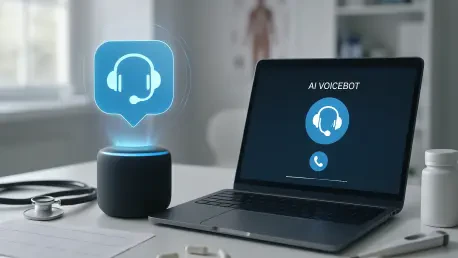In an era where digital solutions are redefining every facet of life, Artificial Intelligence (AI) voicebots have emerged as a groundbreaking force in healthcare, fundamentally altering how patients and providers connect, and offering innovative ways to bridge gaps in accessibility and efficiency. These sophisticated conversational systems, powered by advanced natural language processing, go beyond mere technological gimmicks to address pressing challenges like accessibility, patient engagement, and operational inefficiencies. From offering real-time guidance to automating burdensome tasks, voicebots are proving to be indispensable allies in a strained healthcare landscape. Their ability to mimic human interaction while handling complex medical queries makes them a bridge between technology and personal care. As the demand for efficient, inclusive, and cost-effective healthcare grows, these tools are stepping in to fill critical gaps, promising a future where digital interactions are as compassionate as they are effective. This exploration delves into the myriad ways voicebots are reshaping the industry, highlighting their impact on both individual experiences and systemic operations.
Revolutionizing Patient Connections
The personalization offered by AI voicebots marks a significant departure from the one-size-fits-all approach of traditional digital healthcare platforms. These systems excel at tailoring interactions to meet specific patient needs, whether it’s providing reminders for medication, scheduling follow-up visits, or offering step-by-step guidance for managing chronic illnesses. By understanding and responding to natural language, voicebots create a sense of familiarity and trust that static interfaces often lack. Reports indicate a striking 60% surge in patient satisfaction attributed to these customized exchanges, as patients feel heard and supported in a way that mirrors human conversation. This shift is especially impactful for those who struggle with navigating complex medical systems, ensuring that vital information is delivered in an approachable, digestible manner. The result is not just improved compliance with treatment plans but also a deeper emotional connection to care providers, even in a digital space.
Beyond individual comfort, the role of voicebots in fostering consistent engagement transforms the patient experience into a proactive journey. For individuals managing long-term conditions like diabetes or hypertension, regular check-ins and health monitoring become seamless through voice-driven reminders and advice. Unlike automated text messages or emails that can be easily ignored, the conversational tone of voicebots encourages active participation, making patients feel as though a caring assistant is by their side. This dynamic interaction also allows for real-time feedback, enabling healthcare providers to adjust care plans based on immediate patient input. Such adaptability is crucial in a field where timing can mean the difference between prevention and crisis. By bridging the gap between impersonal technology and human empathy, voicebots are redefining how sustained engagement can lead to better health outcomes, particularly for those who might otherwise fall through the cracks of an overburdened system.
Streamlining Healthcare Operations
AI voicebots are proving to be a lifeline for healthcare facilities grappling with administrative overload and staff shortages by automating routine yet time-consuming tasks. Functions such as appointment scheduling, patient triage, and clinical documentation, which often bog down medical professionals, are now handled with precision by these intelligent systems. Integration with electronic health records (EHRs) ensures that data flows smoothly between interactions, slashing errors and saving critical time. Studies reveal that such automation has driven productivity increases of up to 40%, a vital boost when patient volumes continue to rise. This efficiency translates into tangible benefits, allowing clinicians to redirect their focus from paperwork to direct patient care. In an environment where every minute counts, voicebots offer a practical solution to maintain high standards of service without sacrificing quality or overburdening staff.
Moreover, the cost-saving potential of voicebots cannot be overstated, as they reduce the need for extensive call center operations and manual labor in administrative roles. Healthcare organizations, often stretched thin by tight budgets, find in these tools an opportunity to optimize resources without compromising on patient interaction quality. The ability to handle multiple queries simultaneously—something human staff cannot replicate—means faster response times and fewer bottlenecks during peak periods. This scalability is particularly beneficial for hospitals and clinics facing sudden surges in demand, ensuring that no patient is left waiting for basic assistance. By alleviating these operational pressures, voicebots not only enhance the workflow within medical settings but also contribute to a more sustainable financial model for healthcare delivery, proving that technology can be both compassionate and economical in addressing systemic challenges.
Breaking Barriers to Access
Accessibility in healthcare receives a profound boost from AI voicebots, particularly for populations in rural or underserved regions where specialist care is often out of reach. These systems eliminate the need for advanced technical skills or literacy, making health services available to a broader demographic through simple voice commands. Multilingual support further enhances their reach, allowing non-English speakers to access critical information in their native languages. During the COVID-19 pandemic, voicebots played a pivotal role in disseminating accurate public health updates to diverse communities, demonstrating their capacity to bridge geographic and cultural divides. This inclusivity ensures that vital care and education are not limited to those with digital fluency or proximity to urban centers, thereby addressing long-standing disparities in healthcare delivery with a tool that speaks directly to the user’s needs.
Equally important is the way voicebots empower individuals with disabilities or limited mobility to engage with healthcare systems independently. For those who find typing or navigating apps challenging, voice interaction offers a straightforward alternative to seek assistance, schedule appointments, or receive health advice without relying on intermediaries. This autonomy is a game-changer, fostering dignity and self-reliance among patients who might otherwise feel marginalized by conventional digital tools. Additionally, the round-the-clock availability of voicebots means that help is accessible at any hour, a crucial factor for remote areas with scarce medical facilities. By dismantling these barriers, voicebots are not just enhancing access but also redefining equity in healthcare, ensuring that every individual, regardless of location or ability, has a voice in their own care journey, and that voice is heard loud and clear.
Fueling Industry Growth and Innovation
The rapid expansion of the AI voicebot market within healthcare underscores a growing trust in their transformative potential across various applications. Valued at USD 468 million in 2024, this sector is projected to grow at an impressive compound annual growth rate of 38% through 2030, driven by increasing use in telehealth, remote patient monitoring, and call center enhancements. The integration of voice technology with Internet of Things (IoT) devices and wearables further accelerates this trend, embedding voicebots into everyday health management tools. Forecasts suggest that by 2026, a staggering 80% of healthcare interactions will incorporate voice technology, signaling a shift toward it becoming a standard component of care delivery. This momentum reflects an industry-wide recognition of voicebots as not just a passing fad but a foundational element in modernizing how healthcare operates on a global scale.
This market surge is accompanied by a wave of innovation as developers and healthcare providers collaborate to expand the capabilities of voicebots beyond basic functions. Advanced applications are emerging, such as real-time language translation during consultations and integration with diagnostic tools to provide preliminary assessments based on vocal cues. These advancements are supported by substantial investments from tech giants and healthcare institutions alike, eager to capitalize on the efficiency and engagement voicebots offer. The growing adoption also highlights a cultural shift among patients and providers, who increasingly view voice-driven interactions as a natural extension of digital care. As this technology becomes more embedded in daily practices, it paves the way for a healthcare ecosystem where seamless, voice-activated communication is the norm, driving both accessibility and operational excellence to new heights.
Navigating Future Horizons with Responsibility
As AI voicebots prepare for deeper integration into clinical systems, their potential to offer empathetic conversations and predictive health insights through continuous monitoring is becoming evident. With 30% of healthcare organizations already utilizing voice AI for diagnostics and telehealth, the path to widespread adoption appears clear and inevitable. Future iterations of these tools are expected to anticipate patient needs by analyzing patterns in health data, providing proactive coaching that could prevent complications before they arise. This forward-looking capability promises to elevate voicebots from reactive assistants to strategic partners in health management. However, this evolution must be matched by robust frameworks to ensure that such advancements do not compromise the personal touch that remains at the heart of effective medical care, balancing tech-driven insights with genuine human concern.
Simultaneously, the future of voicebots in healthcare hinges on addressing critical ethical and trust-related challenges to safeguard their responsible use. Emerging regulatory guidelines are prioritizing data privacy, clinical accuracy, and ethical deployment to protect patient information and maintain reliability in medical contexts. These measures are essential as voicebots handle increasingly sensitive interactions, ensuring that innovation does not come at the expense of security or trust. Stakeholders across the industry are called to collaborate on standards that prevent misuse while fostering public confidence in voice technology. By tackling these concerns head-on, the healthcare sector can harness the full potential of voicebots, creating a landscape where digital tools not only enhance efficiency and access but also uphold the highest standards of integrity and care for every patient they serve.
Reflecting on a Voice-Driven Legacy
Looking back, the journey of AI voicebots in healthcare reveals a remarkable shift in how digital tools can address both human and systemic needs with equal finesse. Their ability to personalize patient interactions, streamline operations, and expand access to care marks a turning point in an industry long burdened by inefficiencies and inequities. The surge in market growth and the steady march toward widespread adoption by 2026 stand as testaments to their proven impact, while early ethical considerations lay the groundwork for responsible scaling. As this technology integrates further into daily practices, it becomes clear that voicebots have not just adapted to healthcare’s challenges—they have redefined the very nature of patient-provider engagement. Moving forward, the focus should rest on refining these systems for even greater empathy and precision, ensuring that future innovations continue to prioritize patient trust and systemic sustainability in equal measure.









